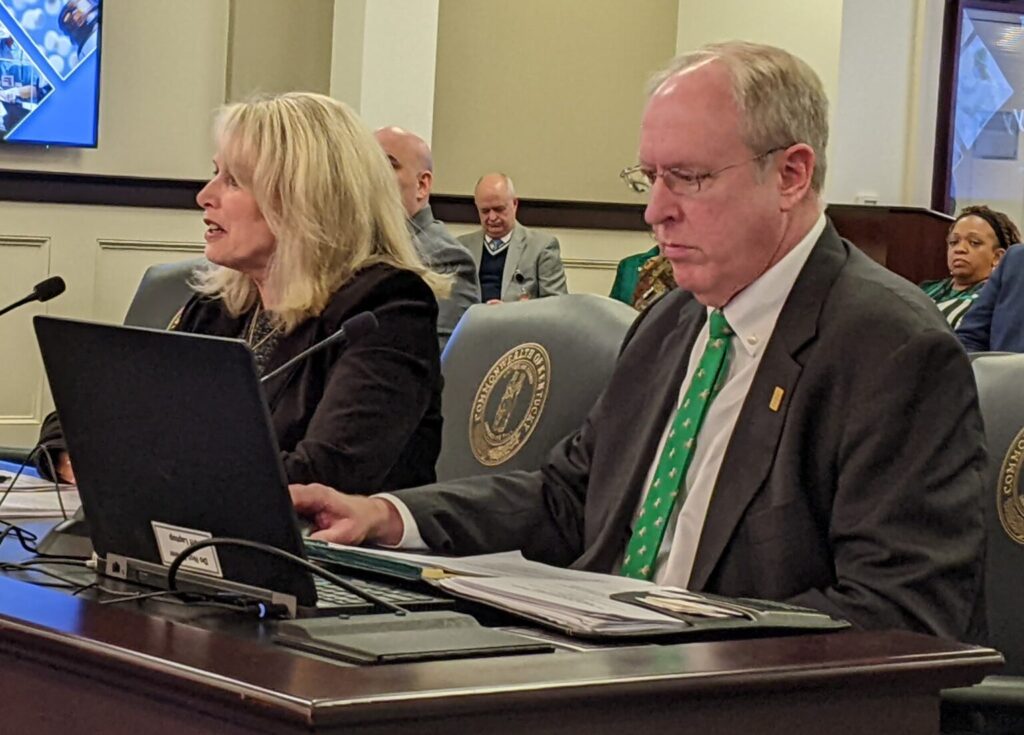Kentucky’s Hospital Rate Improvement Program has not only helped to keep hospitals open, but has also improved patient outcomes, according to the leader of the Kentucky Hospital Association.

Nancy Galvagni, president and CEO of the association, told the Jan. 9 House Health Services Committee that without the program, Kentucky’s hospitals would be operating at a negative 6% margin, which would result in less access to treatment and services for the people of Kentucky. Kentucky Hospital Association President Nancy Galvagni and KHA Vice President of Policy and Government Affairs Jim Musser gave an overview of the success of the Kentucky Hospital Rate Improvement Program at the Jan. 9 House Health Services Committee. (Photo by Melissa Patrick)
“HRIP has been absolutely transformational for health care in Kentucky. . . . When I meet with hospital CEOs, both large and small, they tell me they don’t know where they’d be without the HRIP program, and some of them tell me they’d probably be closed,” she said.
The Hospital Rate Improvement Program (HRIP) allows Kentucky hospitals to get more money from Medicaid, basing payment on the “average commercial rate” instead of the current Medicaid rate, which is often lower. This legislation was passed under two bills — the first in 2021 addressed higher rates for inpatient care and the second, passed in 2023, addressed higher payments for outpatient care, which is the one that is most beneficial to rural hospitals.
“This is very, very crucial because our base Medicaid payments are well below the actual cost of what it is costing the hospitals to care for Medicaid patients,” Galvagni said. “So this is bringing those payments up to 95% of the average commercial rate.”
Another plus is that the additional $2.2 billion in funding provided by the HRIP program annually to Kentucky’s hospitals comes at no cost to the state because hospitals provide the state match through a provider tax. (Medicaid is jointly funded by federal and state governments with the federal government bearing most of the cost — roughly 80% in Kentucky. The federal government matches every $1 that Kentucky puts into Medicaid with about $2.50.)
HRIP is also a value-based program, which means hospitals have to meet certain quality improvement criteria to receive a portion of the payments.
“So perhaps unsurprisingly, with the addition of the resources that HRIP gives our hospitals to work on quality, quality has measurably improved in a number of areas,” Galvagni said. “Our hospitals have been investing these funds in training, implementing new processes and undertaking additional measures to improve health outcomes for our patients.”
Galvagni spent time going over the many improvements that have resulted from the program, including increases in staff and staff training, reduced Medicaid readmissions, increased sepsis screenings, decreased infection rates, reduced opioid prescribing, increased mental health and substance use screenings and increased screenings for things that impact health, such as transportation and food insecurity.
Galvagni said Kentucky is leading the way with this program and its quality results, and that other states are following the state’s lead.
“We’re proud of the quality improvements of our members,” she said, “and excited about the potential for further transformation of health care in Kentucky.”
This story is republished with permission from Kentucky Health News. Read the original.
Melissa Patrick is a reporter for Kentucky Health News, an independent news service of the Institute for Rural Journalism and Community Issues, based in the School of Journalism and Media at the University of Kentucky, with support from the Foundation for a Healthy Kentucky. She has received several competitive fellowships, including the 2016-17 Nursing and Health Care Workforce Media Fellow of the Center for Health, Media & Policy, which allowed her to focus on and write about nursing workforce issues in Kentucky; and the year-long Association of Health Care Journalists 2017-18 Regional Health Journalism Program fellowship. She is a former registered nurse and holds degrees in journalism and community leadership and development from UK.





